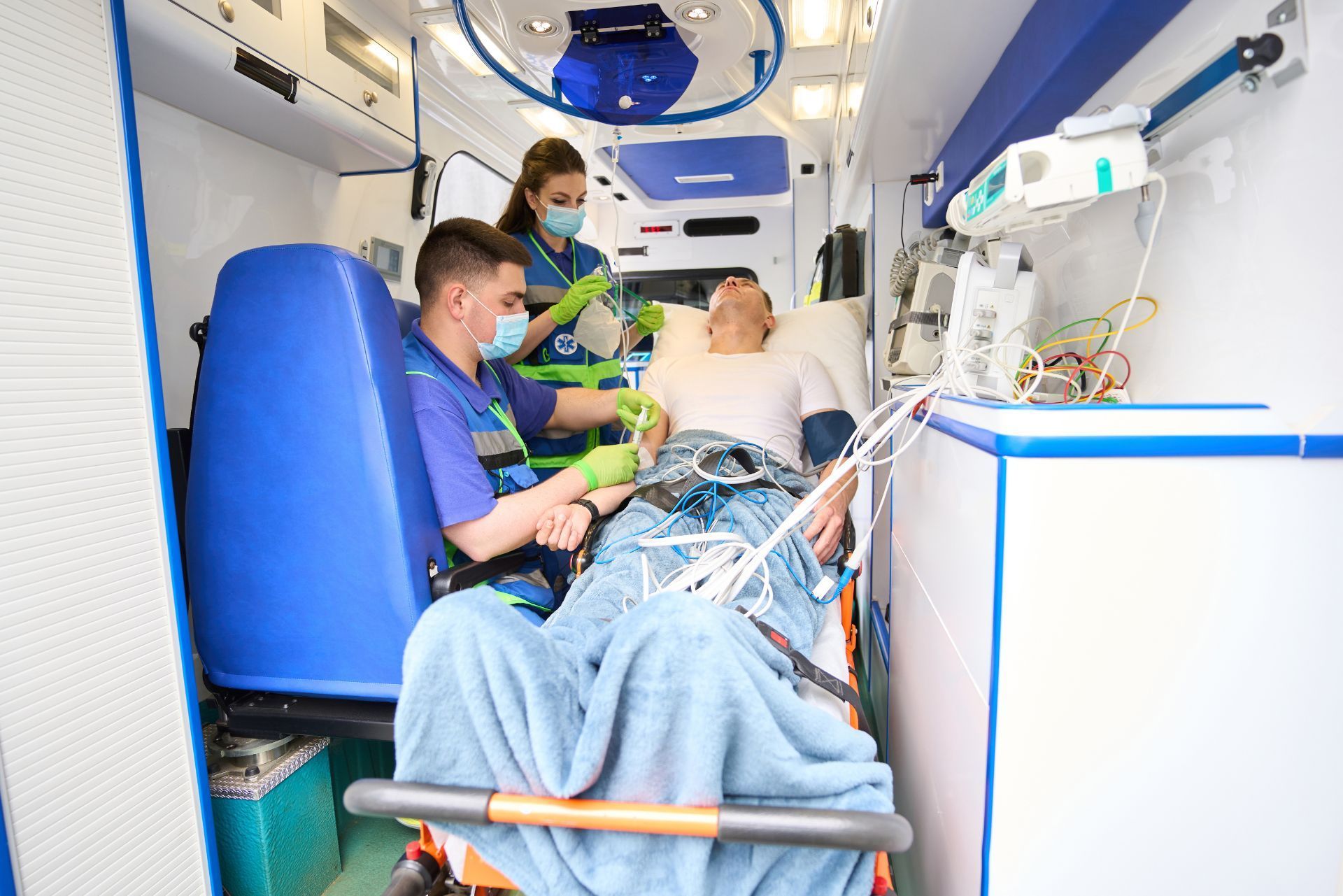Top 3 Recommended Policies

Medical transport insurance is an essential aspect of healthcare logistics, especially in states like Louisiana where access to medical facilities can sometimes be challenging. This article delves into the intricacies of medical transport insurance, exploring its importance, coverage options, and how it operates within the state of Louisiana.
Understanding Medical Transport Insurance
Medical transport insurance is designed to cover the costs associated with transporting patients to and from medical facilities. This can include ground ambulances, air ambulances, and other forms of medical transport. The need for such insurance arises from the fact that medical transport can be a significant expense, especially in emergencies. In many cases, the cost of transport can be as high as several thousand dollars, depending on the distance and the type of transport required, making it essential for individuals to consider their coverage options carefully.
Types of Medical Transport
There are primarily two types of medical transport: ground and air. Ground transport typically involves ambulances equipped with the necessary medical equipment and personnel. These ambulances are staffed by trained paramedics and emergency medical technicians (EMTs) who can provide immediate care during transit. On the other hand, air transport is often used for critical cases requiring rapid response, such as air ambulances, which are equipped with advanced medical technology and staffed by specialized medical teams. Air transport can be particularly advantageous in rural areas where access to hospitals may be limited, allowing for quicker intervention in life-threatening situations.
Each type of transport has its own set of insurance requirements and coverage options, which can vary significantly. For instance, while ground ambulances may be covered under standard health insurance plans, air ambulances often require separate coverage due to their higher costs. Understanding these differences is crucial for both providers and patients to ensure adequate protection during medical emergencies. Additionally, some insurance policies may have specific stipulations regarding the types of transport covered, emphasizing the importance of reviewing one's policy details thoroughly.
The Importance of Medical Transport Insurance
Having medical transport insurance is vital for several reasons. First, it alleviates the financial burden that can arise from sudden medical emergencies. Without insurance, patients may face exorbitant costs that can lead to financial strain. In fact, studies have shown that unexpected medical transport expenses can contribute significantly to medical debt, which is a growing concern in the healthcare landscape.
Moreover, medical transport insurance can provide peace of mind, knowing that in the event of an emergency, the necessary transport will be covered. This is particularly important in Louisiana, where geographical challenges can complicate access to timely medical care. In many cases, patients may require transport across state lines to reach specialized facilities, making comprehensive insurance coverage even more critical. Furthermore, understanding the nuances of one’s insurance plan can empower patients to make informed decisions about their healthcare options, ensuring they receive the best possible care when it matters most. With the right coverage in place, individuals can focus on recovery rather than the financial implications of their medical transport needs.
In Louisiana, medical transport insurance can vary widely in terms of coverage options. Policies may cover a range of services, from basic ground transport to advanced air ambulance services. Understanding these options is essential for selecting the right policy.
Basic Coverage
Basic medical transport insurance typically covers ground ambulance services. This includes transportation to the nearest medical facility, which is crucial for non-critical situations. Basic coverage often includes essential medical equipment and personnel to ensure patient safety during transport.
However, it is important to note that basic coverage may not extend to air ambulance services, which can be significantly more expensive. Patients should assess their individual needs and consider additional coverage if they anticipate the need for air transport. Additionally, some policies may have limitations on the distance covered or the types of facilities to which they can transport patients, making it vital for individuals to read the fine print and understand their policy's parameters.
Comprehensive Coverage
Comprehensive medical transport insurance provides a broader range of services, including both ground and air transport. This type of coverage is particularly beneficial for patients with chronic conditions or those who may require frequent medical visits.
Comprehensive policies often include additional benefits such as coverage for specialized medical equipment and personnel during transport. This ensures that patients receive the highest level of care, regardless of their medical condition. Furthermore, comprehensive coverage may also offer support for inter-facility transfers, which can be critical for patients needing specialized treatment at different hospitals. This flexibility can provide peace of mind for families, knowing that their loved ones will receive timely and appropriate care, no matter where they are located in Louisiana.

Factors to Consider When Choosing a Policy
Choosing the right medical transport insurance policy involves careful consideration of various factors. Each patient’s needs are unique, and understanding these factors can help in making an informed decision.
Frequency of Transport
For individuals who require frequent medical transport, such as those undergoing regular treatments or check-ups, a comprehensive policy may be more suitable. This type of policy can provide peace of mind and financial security, knowing that transport costs are covered.
On the other hand, for those who may only need transport occasionally, a basic policy might suffice. Evaluating the frequency of medical visits can help determine the most cost-effective option. Additionally, it’s important to consider the potential for unexpected medical emergencies, which could necessitate more frequent transport than initially anticipated. Patients should also assess whether their transport needs might change over time, as this could influence the type of policy that would be most beneficial in the long run.
Type of Medical Condition
The nature of a patient’s medical condition is another critical factor. Patients with serious or chronic illnesses may require specialized transport services, making comprehensive coverage essential. Conversely, individuals with less critical health issues may find that basic coverage meets their needs.
Furthermore, certain medical conditions may require specific types of transport, such as wheelchair-accessible vehicles or ambulances equipped with medical equipment. It is vital for patients to discuss their specific health requirements with their healthcare provider, who can offer insights into the types of transport that would be most appropriate. Additionally, understanding the level of care needed during transport—whether a medical professional is required to accompany the patient—can also influence the choice of policy. This ensures that patients receive the necessary support during their journey, ultimately contributing to their overall health and safety.
How to Apply for Medical Transport Insurance in Louisiana
Applying for medical transport insurance in Louisiana can be a straightforward process if the necessary steps are followed. Understanding the application process can help ensure that individuals secure the coverage they need.
Researching Providers
The first step in applying for medical transport insurance is to research different insurance providers. It is essential to compare policies, coverage options, and premiums to find the best fit. Online resources and consumer reviews can provide valuable insights into the reputation and reliability of various insurers.
Additionally, consulting with healthcare professionals can offer guidance on which providers are known for their medical transport insurance services. Engaging with local support groups or forums can also yield personal experiences and recommendations from individuals who have navigated the same process. This community insight can be invaluable, as it often highlights the nuances of each provider's service, such as customer support quality and claims processing efficiency.
Gathering Necessary Documentation
Once a suitable provider is identified, the next step is to gather the necessary documentation for the application. This may include personal identification, medical records, and information about any pre-existing conditions. Having this information readily available can streamline the application process.
In addition to the basic documentation, applicants should also consider compiling any relevant financial information, such as income statements or tax returns, which might be required to determine eligibility for certain plans or subsidies. It’s also advisable to prepare a list of any medications currently being taken, as this can affect coverage options and premiums. Ensuring that all documents are accurate and up-to-date will not only facilitate a smoother application process but also help in avoiding potential delays or complications down the line.
The Role of Medicaid and Medicare in Medical Transport Insurance
Medicaid and Medicare play significant roles in medical transport insurance, especially for eligible individuals in Louisiana. Understanding how these programs interact with medical transport can help patients navigate their options.
Medicaid Coverage
Medicaid provides coverage for medical transport services for eligible low-income individuals. In Louisiana, Medicaid may cover ground ambulance services for non-emergency and emergency situations, provided they meet specific criteria.
- It is essential for patients to understand the limitations and requirements of Medicaid coverage, as not all transport services may be included. Patients should contact their Medicaid provider for detailed information regarding their specific coverage. Additionally, it is important to note that prior authorization may be required for certain non-emergency transport services, which can add another layer of complexity to the process. This means that patients should not only be aware of their eligibility but also be proactive in seeking approvals ahead of time to avoid unexpected out-of-pocket costs.
Medicare Coverage
Medicare also offers coverage for medical transport, particularly for beneficiaries who require medically necessary transport. This includes ground ambulance services for emergencies and, in some cases, air ambulance services.
Similar to Medicaid, Medicare has specific guidelines and criteria that must be met for coverage to apply. Patients should familiarize themselves with these guidelines to ensure they receive the necessary benefits. For instance, Medicare typically covers ambulance services only when other forms of transportation could endanger the patient's health. This stipulation emphasizes the importance of having a thorough understanding of one’s medical condition and the necessity of transport, as documentation from healthcare providers may be needed to substantiate the claim. Moreover, beneficiaries should be aware that while Medicare covers a significant portion of the costs, they may still be responsible for deductibles and coinsurance, which can vary based on the type of service received.

Common Challenges and Solutions
While medical transport insurance is crucial, there are common challenges that patients may face. Understanding these challenges and their potential solutions can help individuals navigate the insurance landscape more effectively.
High Premiums
One of the most significant challenges patients may encounter is high premiums associated with medical transport insurance. This can be particularly burdensome for individuals on fixed incomes or those with limited financial resources.
To address this issue, patients can shop around for different policies and providers. Many insurers offer competitive rates, and comparing these can lead to more affordable options. Additionally, exploring state assistance programs may provide financial relief for those who qualify. It is also beneficial to inquire about discounts that may be available for bundling insurance policies or for maintaining a healthy lifestyle, as some insurers reward proactive health management.
Limited Coverage Options
Another challenge is the limited coverage options available in certain areas. In rural parts of Louisiana, for instance, access to comprehensive medical transport services may be restricted, leading to gaps in coverage.
Patients facing this challenge should consider advocating for their needs with insurance providers. Engaging with local healthcare advocates or community organizations can also help raise awareness about the importance of comprehensive medical transport insurance in underserved areas. Furthermore, patients might explore telehealth services as a supplementary option, which can provide access to medical consultations without the need for physical transport, thereby alleviating some of the pressure on transport insurance needs. Collaborating with local health departments to push for improved transport services can also create a ripple effect, potentially leading to better coverage options in the future.
Future Trends in Medical Transport Insurance
The landscape of medical transport insurance is continually evolving, influenced by advancements in technology and changes in the healthcare system. Staying informed about these trends can help patients and providers adapt to the future of medical transport.
Telemedicine Integration
One of the most significant trends is the integration of telemedicine into medical transport services. As telehealth becomes more prevalent, many providers are exploring ways to incorporate virtual consultations into transport services. This can enhance patient care and streamline the transport process.
Insurance policies may begin to reflect this trend, offering coverage for telemedicine consultations that occur during transport. This could lead to more comprehensive care for patients while potentially reducing costs. Furthermore, the ability to connect patients with specialists in real-time during transport can facilitate quicker decision-making, particularly in emergency situations where every second counts. This integration not only improves outcomes but also fosters a more collaborative approach among healthcare providers, ensuring that patients receive the best possible care even before they reach their destination.
Increased Focus on Patient-Centered Care
There is also a growing emphasis on patient-centered care within the medical transport industry. This trend focuses on tailoring services to meet the unique needs of each patient, ensuring that they receive the highest level of care during transport.
As this trend continues, insurance policies may evolve to include additional benefits that prioritize patient comfort and safety. This could include specialized training for transport personnel and enhanced medical equipment. For instance, transport vehicles may be equipped with advanced monitoring systems that allow for real-time tracking of vital signs, ensuring that medical staff can respond promptly to any changes in a patient’s condition. Additionally, the incorporation of comfort measures, such as adjustable seating and soothing environments, can significantly improve the overall experience for patients during what can often be a stressful time. By focusing on these aspects, the medical transport industry can not only improve patient satisfaction but also potentially reduce the need for more intensive medical interventions later on.
Conclusion
Louisiana medical transport insurance is a vital component of the healthcare system, ensuring that patients have access to necessary transport services during emergencies and medical visits. Understanding the various coverage options, application processes, and challenges can empower individuals to make informed decisions about their insurance needs.
As the landscape of medical transport continues to evolve, staying informed about trends and changes will be essential for both patients and providers. By prioritizing adequate insurance coverage, individuals can ensure their health and well-being are safeguarded, no matter the circumstances.
Contact Us

